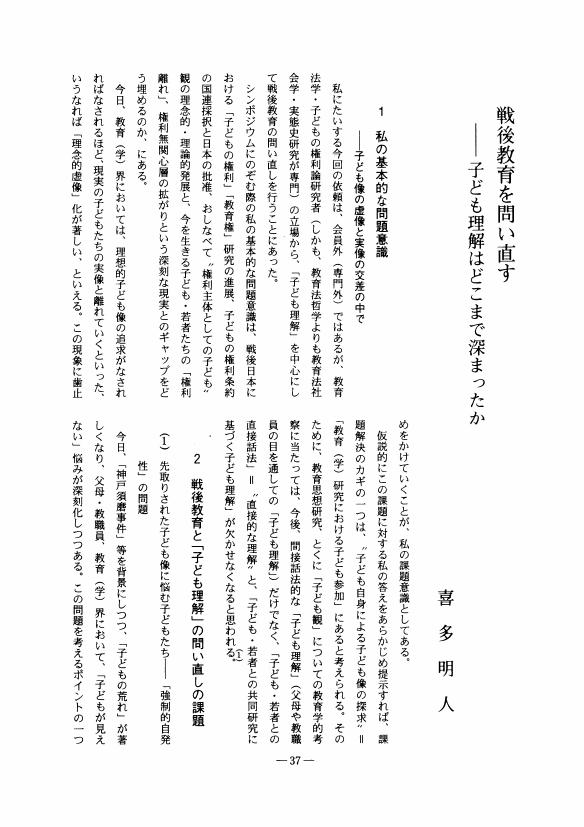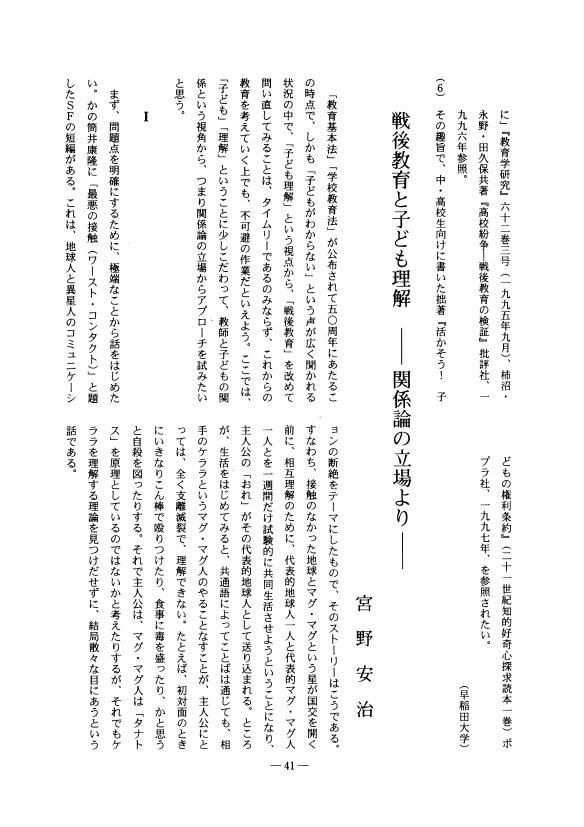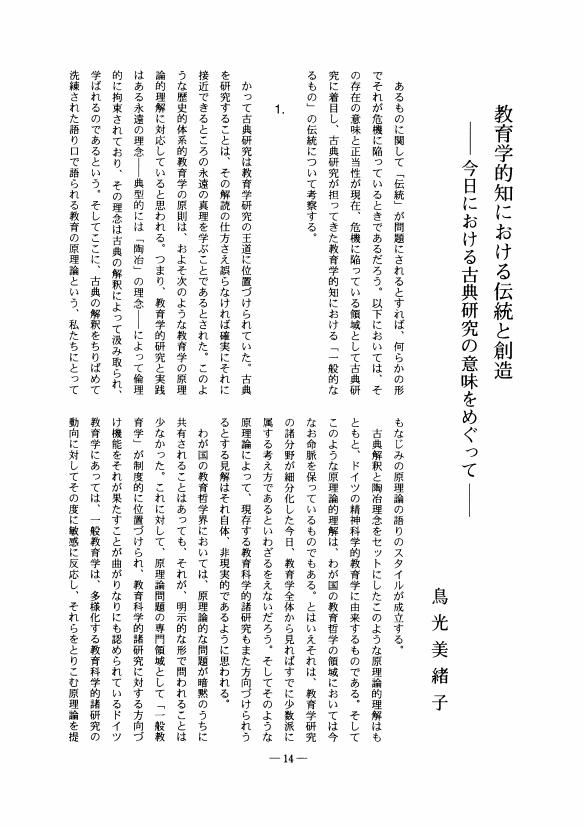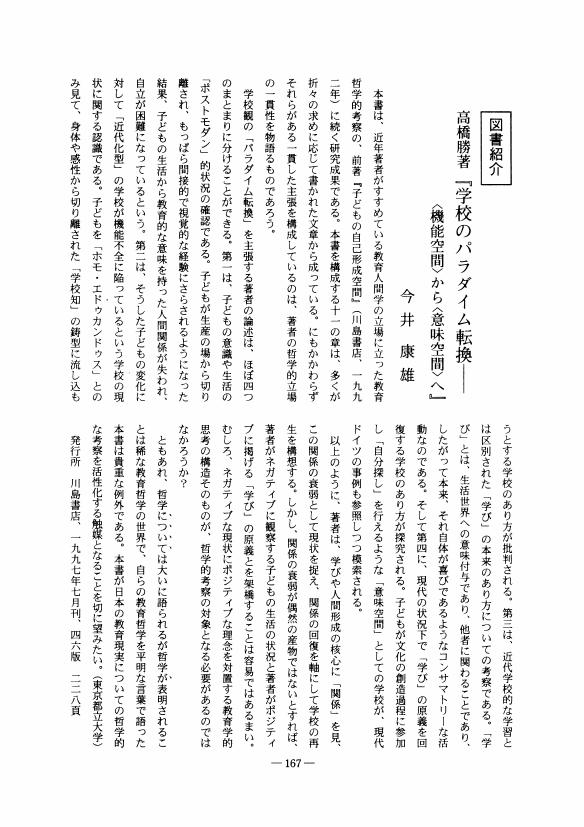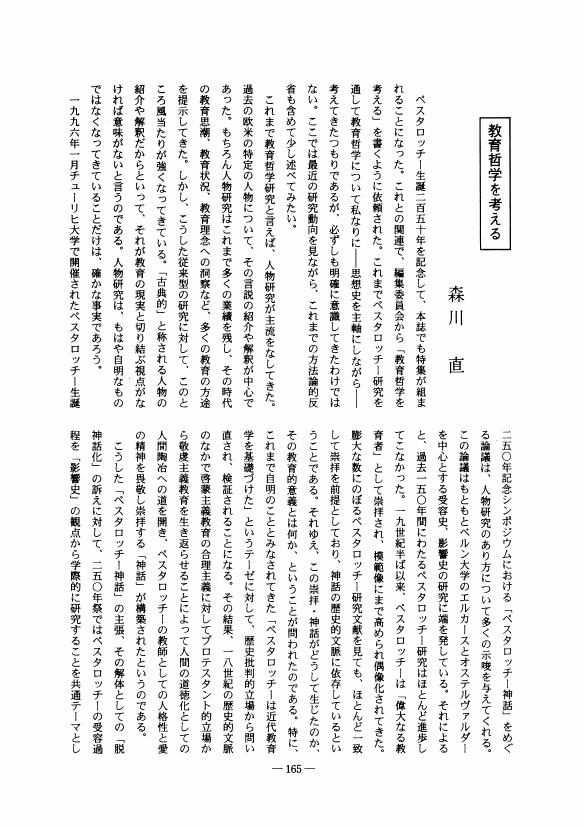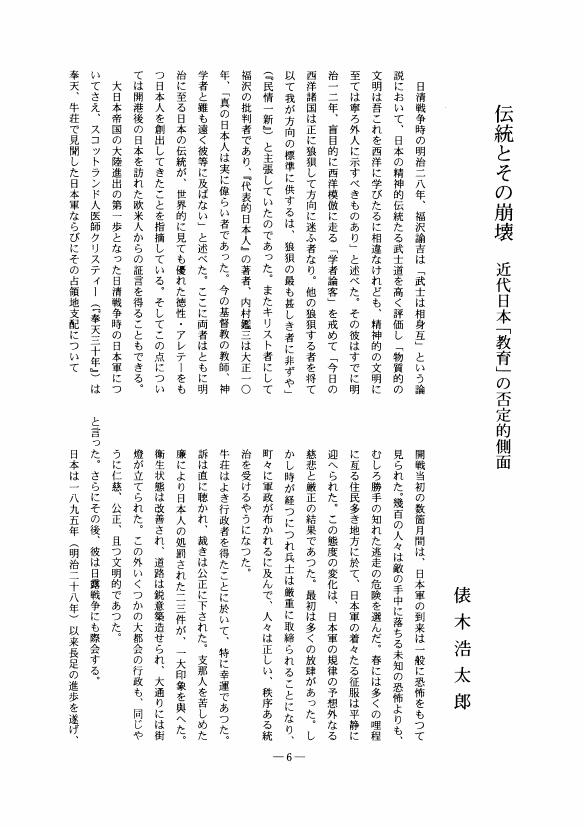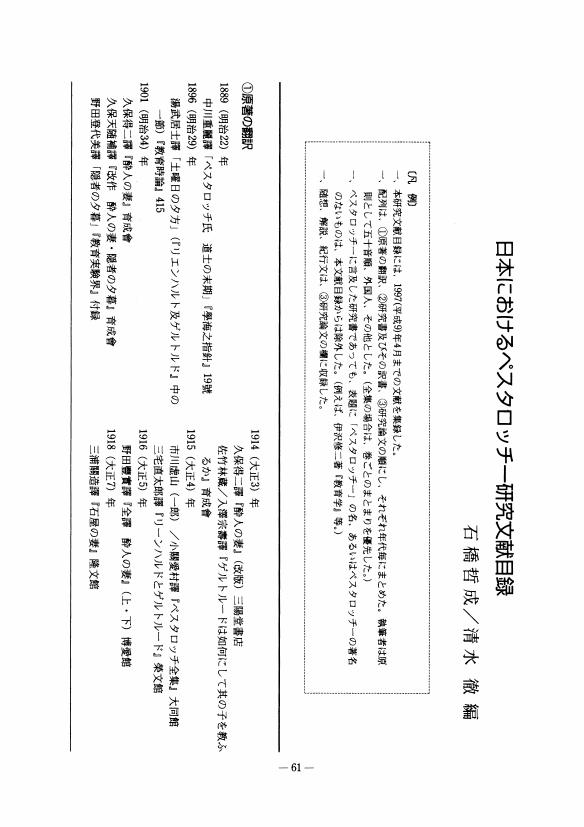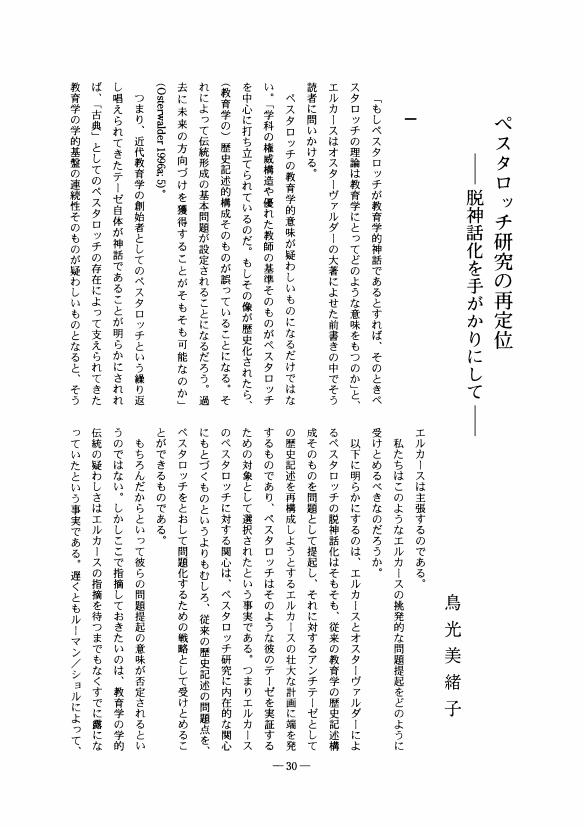1 0 0 0 OA ハーバーマスの討議倫理学における道徳的観点の検討
- 著者
- 西野 真由美
- 出版者
- 教育哲学会
- 雑誌
- 教育哲学研究 (ISSN:03873153)
- 巻号頁・発行日
- vol.1998, no.77, pp.51-64, 1998-05-10 (Released:2009-09-04)
- 参考文献数
- 11
This paper explores the possibility of reconstructing a theory of moral education in a pluralistic society, on the basis of the discourse ethics of Jürgen Habermas. Toward this end the author examines the “moral point of view” in discourse ethics in order to grasp clearly the idea of morality as the rational procedure of conflict adjudication.Discourse ethics represents an attempt to elucidate the rational basis of consensus formation on moral problems through practical discourse. From the universalistic structure of moralpractical discourse, Habermas sheds new light on the abstractive and co-operative features of the point of view of morality.However, his attempt has given rise to much debate in moral theory. This paper deals with the following issues; first, the conflict between ethics of justice and ethics of care, then, second, the differentiation of justice from good life, and lastly, the elimination of the fruitfulness of plurality by the consensus-focused discourse.By identifying the moral point of view with impersonal perspectives that regulate fair social co-operation in the public sphere, Habermas strives on the one hand, to retrieve the critical power of morality against reality, and, on the other hand, to reconcile the fragility of the human beings as individuated, through socialization.This dual function of morality indicates that moral education has to face two tasks at once. Namely, moral education has to provide children with the moral basis in multicultural society by both developing a moral point of view as a transcendental perspective and by nurturing practical reason, or phronesis, which will pave the way for reconstructing the life-world permeated with justice and solidarity.
1 0 0 0 OA 子ども理解はどこまで深まったか
- 著者
- 田中 孝彦
- 出版者
- 教育哲学会
- 雑誌
- 教育哲学研究 (ISSN:03873153)
- 巻号頁・発行日
- vol.1998, no.77, pp.31-36, 1998-05-10 (Released:2009-09-04)
1 0 0 0 OA 課題研究についての報告
- 著者
- 原 聡介 皇 紀夫
- 出版者
- 教育哲学会
- 雑誌
- 教育哲学研究 (ISSN:03873153)
- 巻号頁・発行日
- vol.1998, no.77, pp.47-50, 1998-05-10 (Released:2009-09-04)
1 0 0 0 OA 戦後教育を問い直す 子ども理解はどこまで深まったか
- 著者
- 喜多 明人
- 出版者
- 教育哲学会
- 雑誌
- 教育哲学研究 (ISSN:03873153)
- 巻号頁・発行日
- vol.1998, no.77, pp.37-41, 1998-05-10 (Released:2009-09-04)
- 参考文献数
- 6
1 0 0 0 OA 戦後教育と子ども理解-関係論の立場より-
- 著者
- 宮野 安治
- 出版者
- 教育哲学会
- 雑誌
- 教育哲学研究 (ISSN:03873153)
- 巻号頁・発行日
- vol.1998, no.77, pp.41-46, 1998-05-10 (Released:2009-09-04)
1 0 0 0 OA 《コメニウス・ルネッサンス》の意味
- 著者
- 佐藤 令子
- 出版者
- 教育哲学会
- 雑誌
- 教育哲学研究 (ISSN:03873153)
- 巻号頁・発行日
- vol.1998, no.77, pp.1-5, 1998-05-10 (Released:2009-09-04)
- 参考文献数
- 3
1 0 0 0 OA 伝統と創造の一致-「古典」の見直し-
- 著者
- 吉村 文男
- 出版者
- 教育哲学会
- 雑誌
- 教育哲学研究 (ISSN:03873153)
- 巻号頁・発行日
- vol.1998, no.77, pp.21-26, 1998-05-10 (Released:2009-09-04)
1 0 0 0 OA 教育学的知における伝統と創造 今日における古典研究の意味をめぐって
- 著者
- 鳥光 美緒子
- 出版者
- 教育哲学会
- 雑誌
- 教育哲学研究 (ISSN:03873153)
- 巻号頁・発行日
- vol.1998, no.77, pp.14-21, 1998-05-10 (Released:2009-09-04)
- 参考文献数
- 6
- 著者
- 榑松 かほる
- 出版者
- 教育哲学会
- 雑誌
- 教育哲学研究 (ISSN:03873153)
- 巻号頁・発行日
- vol.1997, no.76, pp.168, 1997-11-10 (Released:2009-09-04)
1 0 0 0 OA 高橋勝著『学校のパラダイム転換 -〈機能空間〉から〈意味空間〉へ』
- 著者
- 今井 康雄
- 出版者
- 教育哲学会
- 雑誌
- 教育哲学研究 (ISSN:03873153)
- 巻号頁・発行日
- vol.1997, no.76, pp.167, 1997-11-10 (Released:2010-05-07)
1 0 0 0 OA 教育哲学を考える
- 著者
- 森川 直
- 出版者
- 教育哲学会
- 雑誌
- 教育哲学研究 (ISSN:03873153)
- 巻号頁・発行日
- vol.1997, no.76, pp.165-166, 1997-11-10 (Released:2009-09-04)
1 0 0 0 OA 伝統とその崩壊 近代日本「教育」の否定的側面
- 著者
- 俵木 浩太郎
- 出版者
- 教育哲学会
- 雑誌
- 教育哲学研究 (ISSN:03873153)
- 巻号頁・発行日
- vol.1998, no.77, pp.6-13, 1998-05-10 (Released:2009-09-04)
1 0 0 0 OA 淡水庁志抄録・台湾府誌抄録
1 0 0 0 OA 〔台湾事件ニ関スル対清交渉ニ付柳原公使ニ対スル指令書〕
- 巻号頁・発行日
- 1873
1 0 0 0 OA キルパトリック教育思想における「協同」概念の再検討 個別教授批判をてがかりとして
- 著者
- 佐藤 隆之
- 出版者
- 教育哲学会
- 雑誌
- 教育哲学研究 (ISSN:03873153)
- 巻号頁・発行日
- vol.1997, no.76, pp.138-151, 1997-11-10 (Released:2009-09-04)
- 参考文献数
- 57
William Heard Kilpatrick's educational concept of 'cooperation' has been harshly criticized for the alleged effect of reinforcing conformity to industrial society and to 'other-directedness.' However, by claiming that education must be based, not on individualization, but on the 'cooperative purpose activity, ' Kilpatrick in fact criticized individualized methods of instruction and exerted influence on Helen Parkhurst. Parkhurst, originator of the Dalton Plan, argued for the necessity for each student to share the minimal essentials to live a cooperative community life. She proposed an individualized method of instruction in which she gave students assignments individually in view of greater attention to social efficiency. Kilpatrick has warned that, by presupposing that the basic knowledge thus taught by the individualized instruction had priority over social activities, Parkhurst unintentionally made 'cooperation' so static and exclusive that it could even be seen as a form of conformity or social control. In Parkhurst's scheme, the individual was treated as a passive organism. Being partly based on George Herbert Mead, Kilpatrick's theory claimed that 'cooperation' cannot be established simply by a unified linguistic community, but only by locating 'common ways of cooperating, ' which emerge from diverse points of view in which the self and others interact reciprocal ly, or, the 'self-other process.' According to Mead, Kilpatrick had asserted that 'cooperation' was the reciprocal relationship of the individual and society.
1 0 0 0 OA 現代における人間形成と「美的なもの」 〈ポストモダン〉と〈未完の近代〉の間
- 著者
- 野平 慎二
- 出版者
- 教育哲学会
- 雑誌
- 教育哲学研究 (ISSN:03873153)
- 巻号頁・発行日
- vol.1997, no.76, pp.124-137, 1997-11-10 (Released:2010-05-07)
- 参考文献数
- 29
In diesem Aufsatz werden zwei gegenwärtige päAdagogische Theoriekonzepte-die post-moderne Pädagogik von D. Lenzen und die Kommunikationstheorie von J. Habermas-in Hinsicht auf die Funktion des Ästhetischen in der Menschenbildung vergleichend geprüft. Lenzen hält das Ästhetische für das Andere der Vernunft. Mit dem Begriff pädagogischer Methexis versucht er, die Menschenbildung als ästhetischen Prozeß zu konzipieren und die moderne Pädagogik als Praxiswissenschaft durch Ästhetik zu rekonstruieren. Nach der Habermas' schen Theorie des kommunikativen Handelns wirkt das ästhetische Momenf in der sprachlichen Kommunikation mit seiner welterschließenden Funktion gegen die alltägliche Rationalitat kritisch und reflektiv. Von diesem selbstreflektiven Moment aus wird das gegenwärtige Bildungskonzept möglich, das die Herrschaft von der Systemrationalität und der instrumentellen Vernunft überwinden kann. Beide Konzepte stehen sich in der Beurteilung zu der Moderne entgegen. Aber sie sind in bezug auf die Erfassung der Wirkung des Ästhetischen aufeinander komplementär. Und in der Ambivalenz des Ästhetischen findet sich der Schlüssel zur Überwindung der Aporie der modernen Pädagogik.
- 著者
- 野平 慎二 鳥光 美緒子
- 出版者
- 教育哲学会
- 雑誌
- 教育哲学研究 (ISSN:03873153)
- 巻号頁・発行日
- vol.1997, no.76, pp.48-60, 1997-11-10 (Released:2009-09-04)
- 参考文献数
- 22
This paper discusses the possibility of the rebirth of Pestalozzi as a classical author in pedagogical historiography. For some time by now Pestalozzi's pedagogical values have been based on his establishment of the 'Bildung' idea. Since the arrival of Luhmann/Shchorr's 'Reflexionsproblem im Erziehungssystem' at the latest, however, Pestalozzi's status as a classical author has undergone considerable depreciation because the former sentenced Pestalozzi's idea of 'Bildung' as dysfunctional as a normative guideline for the decision of modern pedagogical problems. This paper examines the recent works by Oelkers and Osterwalder which demythologize Pestalozzi. They pose a radical challenge to the established scholarship on Pestalozzi by claiming that the whole Pestalozzi studies so far have simply contributed to his mythologization. I will argue that the salient accomplishment of demythologization consists in the destruction of the authoritative structure of the past Pestalozzi studies which had the effect of preventing new approaches to the subject, as well as in its location of a new ideological and social context of Pestalozzi's pedagogical ideas. At the same time, however, my analysis shows that the demythologization takes us nowhere with regards to the rebirth of Pestalozzi. Thus I would like to conclude that a way out for the program of his rebirth may be found in Luhmann's suggestion to the effect that the subject matter of study should not be confounded with theory or problem solving. In other words, we should refrain from trying to solve current problems by analyzing classical works. For analysis of classical works becomes valuable only when they are simultaneouly sustained by our theoretical interest in the construction of new theories which will serve for the pedagogical decision making in our own days.
1 0 0 0 OA 日本におけるペスタロッチー研究文献目録
- 著者
- 石橋 哲成 清水 徹編
- 出版者
- 教育哲学会
- 雑誌
- 教育哲学研究 (ISSN:03873153)
- 巻号頁・発行日
- vol.1997, no.76, pp.61-98, 1997-11-10 (Released:2009-09-04)
1 0 0 0 OA 教育における転移と逆転移 献身的な教師の挫折
- 著者
- 毛利 猛
- 出版者
- 教育哲学会
- 雑誌
- 教育哲学研究 (ISSN:03873153)
- 巻号頁・発行日
- vol.1997, no.76, pp.99-109, 1997-11-10 (Released:2009-09-04)
- 参考文献数
- 4
- 被引用文献数
- 1
Freud's concept of transference and counter-transference teaches us why the pedagogical relationship of a type of student and his “devoted teacher” gets complicated. The expectations of a type of student toward his teacher as well as those of the teacher toward his poor student become out of proportion to what actual pegagogical situations warrant. As a consequence, both will remain ultimately unsatisfied. In their partnership, both the student and his “devoted teacher” are destined to be badly disappointed. In his present relations with the teacher, the student undergoes an emotional conflict similar to what he had already experienced with his parents. The “devoted teacher” will be inevitably involved in this same conflict because he himself is also neurotic. In this paper I will clarify that the eagerness of the “devoted teacher” arises from the “unrecognized counter-tranference” which, in turn, derives from his narcissistic desire. I will also refer to the dual tendency in pedagogical attitude which becomes especially conspicuous in a comparison of Freud's and modern attitudes toward counter-transference.
1 0 0 0 OA ペスタロッチ研究の再定位 脱神話化を手がかりにして
- 著者
- 鳥光 美緒子
- 出版者
- 教育哲学会
- 雑誌
- 教育哲学研究 (ISSN:03873153)
- 巻号頁・発行日
- vol.1997, no.76, pp.30-47, 1997-11-10 (Released:2009-09-04)
- 参考文献数
- 16


